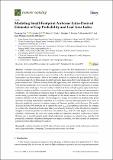| dc.contributor.author | Yin, Tiangang | |
| dc.contributor.author | Qi, Jianbo | |
| dc.contributor.author | Cook, Bruce D. | |
| dc.contributor.author | Morton, Douglas C. | |
| dc.contributor.author | Wei, Shanshan | |
| dc.contributor.author | Gastellu-Etchegorry, Jean-Philippe | |
| dc.date.accessioned | 2020-05-28T14:54:06Z | |
| dc.date.available | 2020-05-28T14:54:06Z | |
| dc.date.issued | 2019-12-18 | |
| dc.date.submitted | 2019-11 | |
| dc.identifier.issn | 2072-4292 | |
| dc.identifier.uri | https://hdl.handle.net/1721.1/125544 | |
| dc.description.abstract | Airborne lidar point clouds of vegetation capture the 3-D distribution of its scattering elements, including leaves, branches, and ground features. Assessing the contribution from vegetation to the lidar point clouds requires an understanding of the physical interactions between the emitted laser pulses and their targets. Most of the current methods to estimate the gap probability ( Pgap ) or leaf area index (LAI) from small-footprint airborne laser scan (ALS) point clouds rely on either point-number-based (PNB) or intensity-based (IB) approaches, with additional empirical correlations with field measurements. However, site-specific parameterizations can limit the application of certain methods to other landscapes. The universality evaluation of these methods requires a physically based radiative transfer model that accounts for various lidar instrument specifications and environmental conditions. We conducted an extensive study to compare these approaches for various 3-D forest scenes using a point-cloud simulator developed for the latest version of the discrete anisotropic radiative transfer (DART) model. We investigated a range of variables for possible lidar point intensity, including radiometric quantities derived from Gaussian Decomposition (GD), such as the peak amplitude, standard deviation, integral of Gaussian profiles, and reflectance. The results disclosed that the PNB methods fail to capture the exact Pgap as footprint size increases. By contrast, we verified that physical methods using lidar point intensity defined by either the distance-weighted integral of Gaussian profiles or reflectance can estimate Pgap and LAI with higher accuracy and reliability. Additionally, the removal of certain additional empirical correlation coefficients is feasible. Routine use of small-footprint point-cloud radiometric measures to estimate Pgap and the LAI potentially confirms a departure from previous empirical studies, but this depends on additional parameters from lidar instrument vendors. Keywords: radiative transfer model; Lidar; airborne laser scan; point cloud; reflectance; leaf area index; gap probability; clumping; Gaussian decomposition; waveform | en_US |
| dc.publisher | Multidisciplinary Digital Publishing Institute | en_US |
| dc.relation.isversionof | 10.3390/rs12010004 | en_US |
| dc.rights | Creative Commons Attribution | en_US |
| dc.rights.uri | https://creativecommons.org/licenses/by/4.0/ | en_US |
| dc.source | Multidisciplinary Digital Publishing Institute | en_US |
| dc.title | Modeling small-footprint airborne lidar-derived estimates of gap probability and leaf area index | en_US |
| dc.type | Article | en_US |
| dc.identifier.citation | Yin, Tiangang, et al., "Modeling small-footprint airborne lidar-derived estimates of gap probability and leaf area index." Remote Sensing 12, 1 (Dec. 2019): no. 4 doi 10.3390/rs12010004 ©2019 Author(s) | en_US |
| dc.contributor.department | Singapore-MIT Alliance in Research and Technology (SMART) | en_US |
| dc.relation.journal | Remote Sensing | en_US |
| dc.eprint.version | Final published version | en_US |
| dc.type.uri | http://purl.org/eprint/type/JournalArticle | en_US |
| eprint.status | http://purl.org/eprint/status/PeerReviewed | en_US |
| dc.date.updated | 2020-03-02T13:00:03Z | |
| dspace.date.submission | 2020-03-02T13:00:03Z | |
| mit.journal.volume | 12 | en_US |
| mit.journal.issue | 1 | en_US |
| mit.license | PUBLISHER_CC | |
| mit.metadata.status | Complete | |
